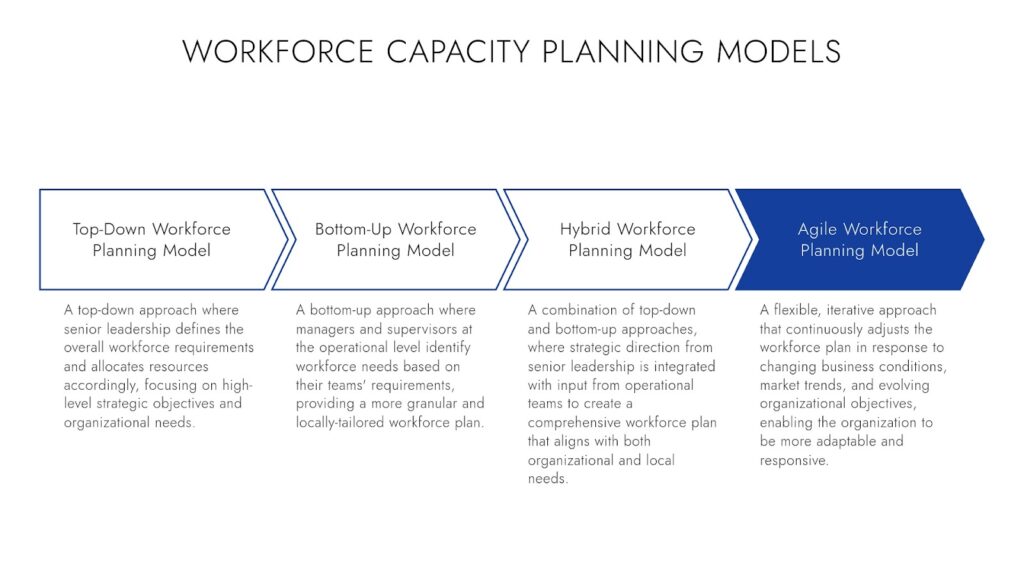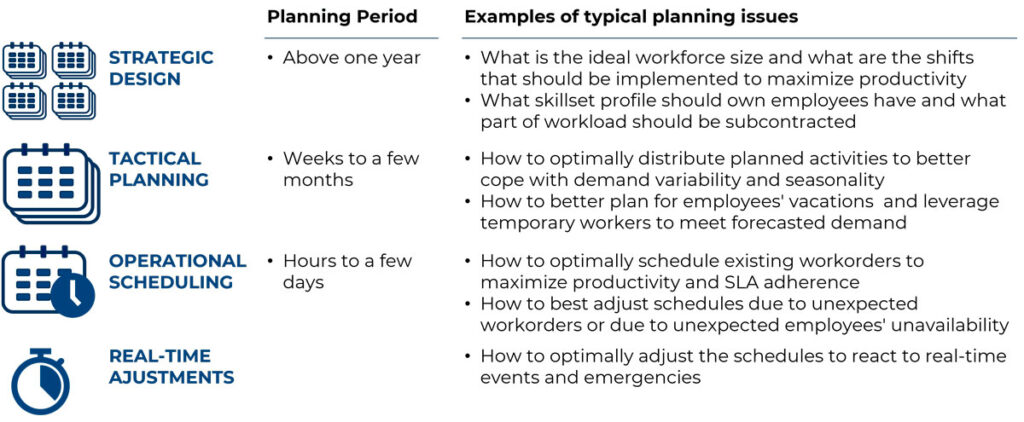Workforce capacity planning is one of the cornerstones of effective human resource (HR) management, enabling organizations to meet their business goals by aligning their workforce capabilities with current and future demands. In today’s fast-paced business world, where organizations need to adapt quickly to changing market conditions, workforce capacity planning ensures that companies have the right number of employees, with the right skills, in the right place at the right time.
Whether you are part of a corporate HR team or a workforce management professional, understanding the intricacies of workforce capacity planning and applying it strategically can help your organization make data-driven decisions, optimize resource allocation, and achieve sustainable growth.
In this article, we’ll walk you through the importance of workforce capacity planning, key planning models, metrics to track, and strategies to address fluctuating demands, ensuring that your business remains agile, efficient, and prepared for whatever lies ahead.
What is Workforce Capacity Planning?

Workforce capacity planning refers to the process of ensuring that an organization has the appropriate number of employees with the right skills to meet its objectives. It is a critical aspect of human resource capacity planning that directly impacts organizational performance, resource allocation, and overall productivity.
Workforce capacity planning involves forecasting staffing needs, identifying skill gaps, analyzing workload trends, and making necessary adjustments to meet current and future business demands. This dynamic process enables organizations to strike the right balance between underutilization and overstaffing, both of which can have adverse effects on business outcomes.
Why is Workforce Capacity Planning Important?
As organizations grow and evolve, the demand for various skills and resources fluctuates. Here’s why workforce capacity planning is essential:
- Improved Resource Allocation: Workforce capacity planning helps ensure that resources are used effectively, reducing the risk of both overstaffing and understaffing.
- Alignment with Business Goals: When workforce needs are aligned with business objectives, organizations can better meet their goals, whether that’s launching a new product, entering a new market, or scaling operations.
- Enhanced Flexibility and Agility: By understanding and forecasting workforce needs, businesses can quickly adapt to shifts in the market or changes in the external environment.
- Cost Control: Proper workforce planning helps control labor costs by ensuring that companies are not paying for unnecessary labor while also preventing costly delays due to staffing shortages.
Key Elements of Workforce Capacity Planning
For effective workforce capacity planning, organizations need to take several factors into account. The following are some of the key elements that should be included in any workforce management capacity planning strategy.
1. Demand Forecasting
Demand forecasting involves predicting the future needs of your workforce based on historical data, business trends, and market analysis. It’s essential to evaluate factors like:
- Productivity trends
- Customer demand
- Project timelines
- Company growth plans
With proper demand forecasting, HR teams can forecast labor needs for months or even years in advance. This also includes understanding peak demand periods and planning accordingly.
2. Skills Assessment
Employee skills assessment is a crucial part of employee capacity planning. By identifying current skills gaps, HR departments can plan for training programs, hiring, or even outsourcing specific tasks. This ensures that the workforce is prepared for future demands.
3. Workforce Utilization
Tracking workforce utilization ensures that employees are being deployed effectively. It also helps identify areas where talent is being underused or overworked. Maximizing employee output while maintaining their well-being and engagement is key to long-term success.
4. Workforce Segmentation
In workforce capacity planning, it’s important to segment the workforce based on different factors such as skill levels, geographic location, and job roles. This segmentation helps identify where the highest demand exists and where there might be an oversupply of resources.
5. Scenario Planning
Given the unpredictability of the labor market and external factors, it’s crucial to conduct scenario planning. HR teams can explore different “what-if” scenarios, such as market downturns, seasonal hiring needs, or the impact of technological changes, and determine how to manage workforce requirements under different circumstances.
Best Workforce Capacity Planning Models for Strategic Growth

There are several models and approaches that can guide your workforce capacity planning efforts. Here are a few that can help you align resources with business objectives.
1. Top-Down Workforce Planning
In this model, senior management sets the overall strategic direction for the organization, and HR aligns the workforce strategy accordingly. The advantage of top-down planning is that it directly reflects the company’s broader goals and objectives, ensuring alignment between leadership and HR departments.
2. Bottom-Up Workforce Planning
This approach takes a more grassroots approach by involving employees and managers in the planning process. Managers who are closest to the work can provide insights into potential capacity constraints, talent shortages, and the types of skills that will be needed in the future.
3. Hybrid Workforce Planning
This model combines the advantages of both top-down and bottom-up approaches. Strategic goals set by leadership are balanced with feedback from operational teams, enabling a more comprehensive workforce plan. It’s particularly useful for organizations that need to manage dynamic and fast-changing environments.
4. Agile Workforce Planning
Agile workforce planning is a flexible, iterative approach to capacity planning that allows for quick adjustments. This model is particularly useful for businesses that face frequent changes or need to scale quickly. It involves continuous monitoring and updating of workforce plans based on changing conditions.
Top Metrics to Track for Successful Workforce Planning
To ensure the effectiveness of your workforce capacity planning efforts, it’s essential to track relevant metrics that provide insights into workforce performance, utilization, and potential gaps. Some key metrics include:
- Workforce Productivity: Measures how efficiently employees are completing tasks relative to their workload. This can be tracked by looking at output per employee or cost per unit of output.
- Employee Engagement: Engaged employees tend to be more productive and committed to organizational success. Tracking employee engagement levels can help identify areas for improvement in capacity planning.
- Turnover Rate: High turnover rates can indicate that employees are not satisfied with their roles, impacting capacity planning. It’s essential to understand the reasons behind turnover to make improvements.
- Skill Utilization Rate: This metric tracks how well employees are utilizing their skills within the organization. It helps identify underutilized talent and areas where employees could be more effective.
- Labor Cost per Unit: This measures the cost of labor relative to output, allowing businesses to evaluate whether they are efficiently utilizing their workforce or if adjustments need to be made.
How to Tackle Workforce Demands with Flexible Strategies?

Image Source: Decisionbrain
One of the biggest challenges in workforce capacity planning is managing fluctuating demands. Business needs are rarely static, and seasonal peaks, new project demands, or unexpected market shifts can all impact workforce requirements.
Here are some strategies to address fluctuating demands:
1. Cross-Training Employees
Cross-training allows employees to acquire additional skills, making them more flexible and adaptable to changes in demand. This can reduce dependency on specific roles and ensure that employees are ready to step in when needed.
2. Flexible Staffing Models
Incorporating temporary or contract workers into your workforce can provide flexibility when demand spikes. This allows companies to quickly adjust headcount without committing to permanent hires.
3. Outsourcing
Outsourcing non-core functions or tasks can help organizations quickly scale their workforce capacity when demand is high. This is particularly useful for specialized functions where permanent hires may not be immediately necessary.
4. Real-Time Analytics and Forecasting
Using global HR software and AI-powered tools can provide real-time insights into workforce data, making it easier to forecast demand and adjust staffing plans accordingly. Predictive analytics can also help anticipate future trends, allowing businesses to proactively adjust their capacity plans.
Conclusion
Mastering workforce capacity planning is critical for organizations seeking to optimize resource allocation, enhance flexibility, and drive long-term success. By implementing the right planning models, tracking relevant metrics, and employing strategies to manage fluctuating demand, companies can ensure that their workforce is always ready to meet business challenges head-on.
As workforce needs continue to evolve, leveraging modern technologies such as global HR software can provide HR departments with the tools they need to stay ahead of the curve. Through diligent capacity planning and the use of predictive insights, organizations can create a resilient workforce that not only meets current needs but is also prepared for future growth.
Effective workforce capacity planning isn’t just about ensuring there are enough employees; it’s about strategically aligning human resources with business goals. By doing so, businesses can empower their employees, reduce costs, and maximize productivity – driving organizational success for years to come.
Access powerful data insights and streamline your hiring and workforce management strategies with JobsPikr. Sign up today!



